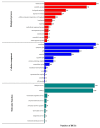Analyzing Differentially Expressed Genes and Pathways Associated with Pistil Abortion in Japanese Apricot via RNA-Seq
- PMID: 32942711
- PMCID: PMC7565994
- DOI: 10.3390/genes11091079
Analyzing Differentially Expressed Genes and Pathways Associated with Pistil Abortion in Japanese Apricot via RNA-Seq
Abstract
Reproduction is a critical stage in the flower development process, and its failure causes serious problems affecting fruit quality and yield. Pistil abortion is one of the main factors in unsuccessful reproduction and occurs in many fruit plants. In Japanese apricot, the problem of pistil abortion is very common and affects fruit quality and plant yield; however, its molecular mechanism is not clearly understood. Therefore, in the current study, we used RNA-Seq to identify the differentially expressed genes (DEGs) and pathways actively involved in pistil abortion. A total of 3882 differentially expressed genes were found after cutoff and pairwise comparison analysis. According to KEGG pathway analysis, plant hormone signaling transduction and metabolic pathways were found most significantly enriched in this study. A total of 60 transcription factor families such as MADS-box, NAC and TCP showed their role in this process. RT-qPCR assays confirmed that the expression levels were consistent with RNA-Seq results. This study provides an alternative to be considered for further studies and understanding of pistil abortion processes in Japanese apricot, and it provides a reference related to this issue for other deciduous fruit crops.
Keywords: Japanese apricot; RNA-Seq; hormone signaling; metabolic pathways; pistil abortion.
Conflict of interest statement
The authors declare that they have no conflicts of interest.
Figures






Similar articles
-
Identification of differentially-expressed genes associated with pistil abortion in Japanese apricot by genome-wide transcriptional analysis.PLoS One. 2012;7(10):e47810. doi: 10.1371/journal.pone.0047810. Epub 2012 Oct 16. PLoS One. 2012. PMID: 23091648 Free PMC article.
-
Comprehensive transcriptomic and metabolomic analysis revealed distinct flavonoid biosynthesis regulation during abnormal pistil development in Japanese apricot.Genomics. 2022 Sep;114(5):110451. doi: 10.1016/j.ygeno.2022.110451. Epub 2022 Aug 18. Genomics. 2022. PMID: 35988654
-
Identification of key genes and regulators associated with carotenoid metabolism in apricot (Prunus armeniaca) fruit using weighted gene coexpression network analysis.BMC Genomics. 2019 Nov 20;20(1):876. doi: 10.1186/s12864-019-6261-5. BMC Genomics. 2019. PMID: 31747897 Free PMC article.
-
Next-Generation Sequencing Sheds New Light on Small RNAs in Plant Reproductive Development.Curr Issues Mol Biol. 2018;27:143-170. doi: 10.21775/cimb.027.143. Epub 2017 Sep 8. Curr Issues Mol Biol. 2018. PMID: 28885180 Review.
-
The Multi-Pistil Phenomenon in Higher Plants.Plants (Basel). 2025 Apr 4;14(7):1125. doi: 10.3390/plants14071125. Plants (Basel). 2025. PMID: 40219193 Free PMC article. Review.
Cited by
-
Genome-Wide Identification of the KNOX Gene Family in Japanese Apricot (Prunus mume Sieb. et Zucc.) and Functional Characterization of PmKNAT2 Genes.Genes (Basel). 2023 Apr 18;14(4):939. doi: 10.3390/genes14040939. Genes (Basel). 2023. PMID: 37107697 Free PMC article.
-
Integrated physiological analyses, transcriptome, and DNA methylation reveal superiority of pear stigma-style complex development regulation.iScience. 2024 Jun 24;27(7):110372. doi: 10.1016/j.isci.2024.110372. eCollection 2024 Jul 19. iScience. 2024. PMID: 39055924 Free PMC article.
-
Glyphosate-Induced Abscisic Acid Accumulation Causes Male Sterility in Sea Island Cotton.Plants (Basel). 2023 Feb 27;12(5):1058. doi: 10.3390/plants12051058. Plants (Basel). 2023. PMID: 36903918 Free PMC article.
-
Bioinformatics Study of Aux/IAA Family Genes and Their Expression in Response to Different Hormones Treatments during Japanese Apricot Fruit Development and Ripening.Plants (Basel). 2022 Jul 22;11(15):1898. doi: 10.3390/plants11151898. Plants (Basel). 2022. PMID: 35893602 Free PMC article.
-
Genome-Wide Identification and Analysis of the Hsp40/J-Protein Family Reveals Its Role in Soybean (Glycine max) Growth and Development.Genes (Basel). 2023 Jun 12;14(6):1254. doi: 10.3390/genes14061254. Genes (Basel). 2023. PMID: 37372434 Free PMC article.
References
-
- Adachi M., Suzuki Y., Mizuta T., Osawa T., Adachi T., Osaka K., Suzuki K., Shiojima K., Arai Y., Masuda K., et al. The “Prunus mume Sieb. et Zucc” (Ume) is a Rich Natural Source of Novel Anti-Cancer Substance. Int. J. Food Prop. 2007;10:375–384. doi: 10.1080/10942910600547624. - DOI
-
- Chu M. Chinese Fruit Tree: Prunus mume. China Forestry Publishing House; Beijing, China: 1999.
-
- Gao S.M., Ma K., Du X.H., Li F.L. Advances in research on Xanthoceras sorbifolia. Chin. Bull Bot. 2002;19:296–301.
Publication types
MeSH terms
Substances
LinkOut - more resources
Full Text Sources

